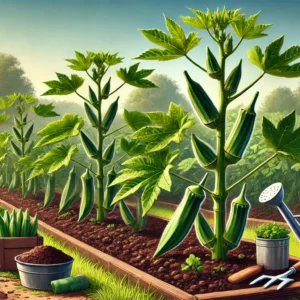History of ginger, Origin of ginger, Ginger medicinal benefits, Ginger health benefits, How to Grow Ginger, Care for Ginger Plant, Pests and Diseases of Ginger Plant: Symptoms, Causes, Cures and Prevention
Ginger gardening is a fun and rewarding activity that lets you grow a useful and tasty plant at home. Whether you’re new to gardening or have some experience, this guide will help you learn everything you need to know about growing ginger.
In this guide, we’ll start with a bit of history, sharing how ginger has been used and valued over the years. Then, we’ll go step-by-step through the process of growing ginger, from planting to caring for your plants. You’ll learn how to pick the right soil, water your plants, and make sure they get enough sunlight.
We’ll also talk about how to fertilize your ginger plants to help them grow strong and healthy. Plus, we’ll cover how to deal with common pests and diseases that can affect ginger plants.
At the end of this guide, we have a section with answers to common questions about ginger gardening. This includes helpful tips and advice to make your ginger gardening experience a success.
By the end of this guide, you’ll have the knowledge and confidence to grow your own ginger at home. Let’s get started on this exciting journey into the world of ginger gardening!
Table of Content
- History of Ginger
- Health Benefit of Ginger
- How to Grow Ginger
- Care for Ginger Plant based of each growth stage
- Pests and Diseases of Ginger Plant: Symptoms, Causes, Cures and Prevention
History of Ginger
Ginger is one of the most ancient and versatile spices in the world, revered for its medicinal, culinary, and aromatic properties. This article delves into the rich history of ginger, exploring its origins, ancient uses, cultural significance, and its journey through trade routes across the globe.
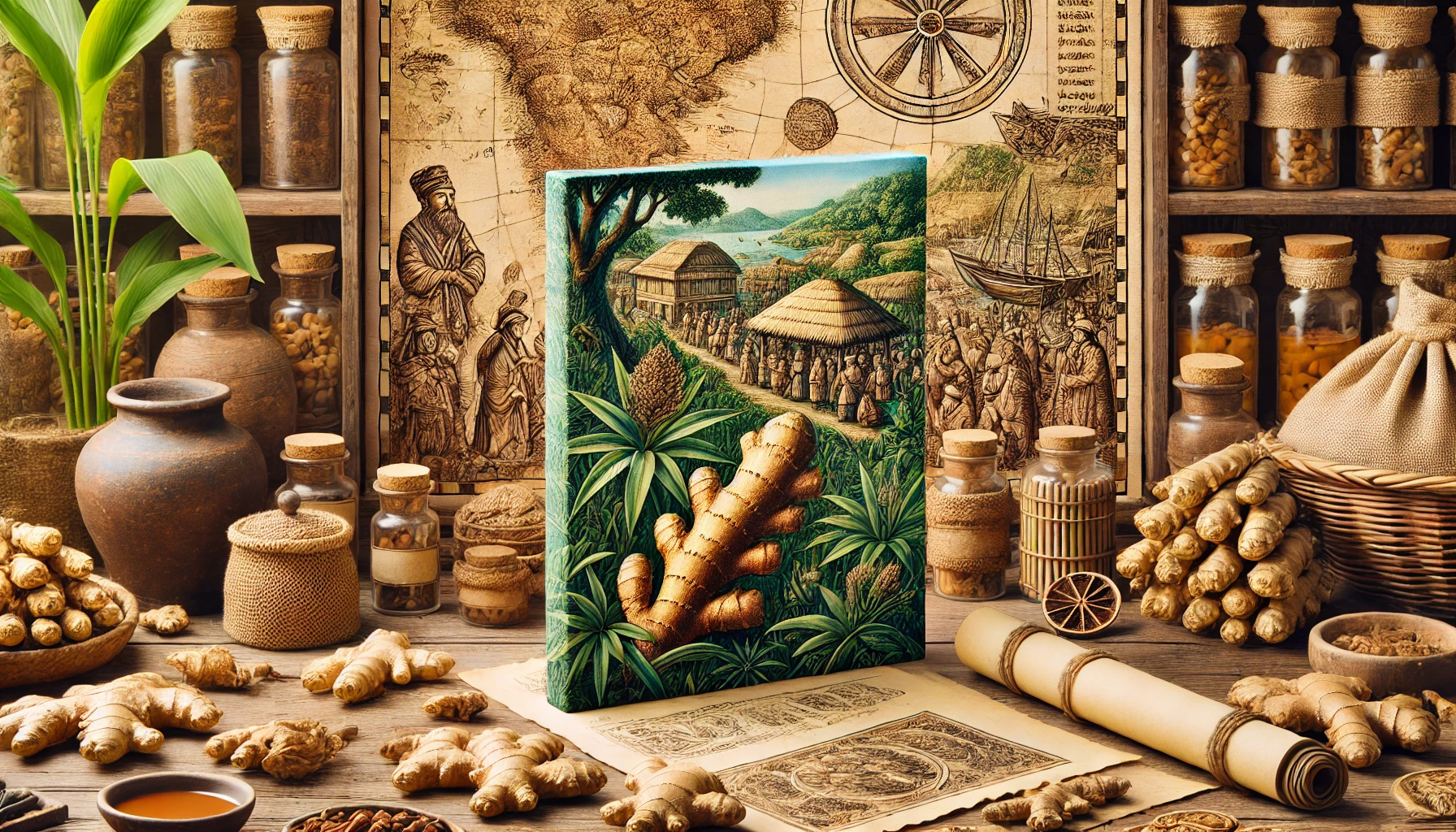
1. Origins of Ginger
Ginger (Zingiber officinale) is believed to have originated in the tropical rainforests of Southeast Asia. The first recorded use of ginger dates back over 5,000 years in ancient China and India, where it was prized not only as a spice but also as a powerful medicine.
The earliest references to ginger come from Sanskrit, Chinese, Greek, Roman, and Arabic texts. In these cultures, ginger was not only a common ingredient in cooking but also a staple in traditional medicine. Its migration from Asia to the rest of the world can be attributed to ancient trade routes that facilitated the exchange of goods and knowledge between civilizations.
2. Ginger in Ancient Medicine
Ginger’s medicinal properties were documented in ancient Chinese and Indian texts. In China, it was used to treat digestive issues, nausea, and inflammation. Indian Ayurvedic medicine also revered ginger for its ability to enhance digestion, boost immunity, and combat respiratory ailments.
– Ginger in Chinese Medicine
Ancient Chinese texts, such as the “Shen Nong Ben Cao Jing” (Divine Farmer’s Materia Medica), mention ginger as a remedy for a variety of ailments. It was used to warm the body, treat colds, and improve digestion. Ginger tea was a common preparation for colds and flu, providing warmth and relief from symptoms.
– Ginger in Ayurvedic Medicine
In Ayurveda, ginger is known as “Vishvabhesaj,” meaning “universal medicine.” It was used in various forms, including fresh, dried, powdered, and juice, to treat a range of conditions from digestive disorders to arthritis. Ayurvedic practitioners believed that ginger could balance the doshas (Vata, Pitta, and Kapha), making it a versatile remedy in holistic healing.
3. Ginger in Culinary History
Ginger has been a staple in culinary traditions around the world. It was used in both savory and sweet dishes, from Indian curries to Chinese stir-fries and Western desserts.
– Ginger in Ancient Cuisine
In ancient Rome, ginger was imported from India and used to make spiced cakes and breads. The Romans believed that ginger could warm the stomach and improve digestion, making it a popular addition to many dishes. It was also a key ingredient in medieval European cuisine, where it was used to flavor meats, sauces, and pastries. Gingerbread, a popular medieval treat, owes its origins to this period.
– Ginger in Modern Cuisine
Today, ginger is a global culinary staple. It is used in everything from Japanese sushi to Jamaican jerk seasoning, showcasing its versatility and enduring popularity. Fresh ginger is often used in Asian stir-fries and marinades, while ground ginger is a common spice in baking. Ginger ale and ginger beer are popular beverages that highlight the spice’s unique flavor.
4. Ginger Trade Routes
Ginger played a significant role in the spice trade, contributing to its spread across the globe. It was one of the first spices to be traded from Asia to Europe and the Middle East.
– The Silk Road and Maritime Routes
Ginger traveled along the Silk Road, a network of trade routes connecting the East and West. Merchants transported dried ginger roots and ground ginger powder, making it accessible to various regions. It was also transported via maritime routes, reaching the Mediterranean and beyond. The ancient spice trade routes facilitated the exchange of not only spices but also cultural practices and medicinal knowledge.
– The Role of Arab Traders
Arab traders were instrumental in introducing ginger to the Mediterranean region. They controlled much of the spice trade and brought ginger to Europe, where it became highly sought after. The famous Venetian explorer Marco Polo mentioned ginger in his travel accounts, noting its value and widespread use.
5. Cultural Significance of Ginger
Ginger has held cultural significance in various societies throughout history. It was often associated with health, prosperity, and protection.
– Ginger in Asian Culture
In China and India, ginger was not only a culinary and medicinal staple but also a symbol of strength and health. It was often used in traditional rituals and ceremonies. In Chinese New Year celebrations, ginger is used in dishes to symbolize wealth and longevity. In India, ginger is used in numerous rituals, particularly those associated with healing and wellness.
– Ginger in Western Culture
In medieval Europe, ginger was a luxury item, often given as a gift or used in festive dishes. It was believed to have warming properties and was used in winter dishes to provide warmth. During the Renaissance, ginger was incorporated into a variety of foods, including spiced wine and desserts.
6. Modern Uses of Ginger
Today, ginger continues to be valued for its health benefits and culinary versatility. It is used in various forms, including fresh, dried, powdered, and as an essential oil.
– Medicinal Uses
Modern medicine recognizes ginger’s ability to alleviate nausea, reduce inflammation, and improve digestion. It is also being studied for its potential role in cancer prevention and treatment. Ginger supplements and extracts are popular for their anti-inflammatory and antioxidant properties, which can help manage conditions like arthritis and cardiovascular disease.
– Culinary Uses
Ginger remains a favorite in global cuisines, used in teas, soups, desserts, and savory dishes. Its unique flavor and health benefits make it a popular choice for chefs and home cooks alike. Ginger is often paired with garlic in savory dishes, and it complements fruits like apples and pears in sweet recipes.
Ginger’s rich history is a testament to its enduring value and versatility. From its origins in ancient Southeast Asia to its widespread use in modern kitchens and medicine cabinets, ginger continues to be a beloved spice and remedy around the world.
The Health Benefits of Homegrown Ginger
Ginger, a tropical plant known for its aromatic and spicy rhizome, has been used for centuries in cooking and traditional medicine. Growing your own ginger at home not only provides a fresh and constant supply of this versatile root but also ensures that you have a chemical-free product. In this article, we will explore the numerous health benefits of homegrown ginger and why you should consider adding it to your garden.
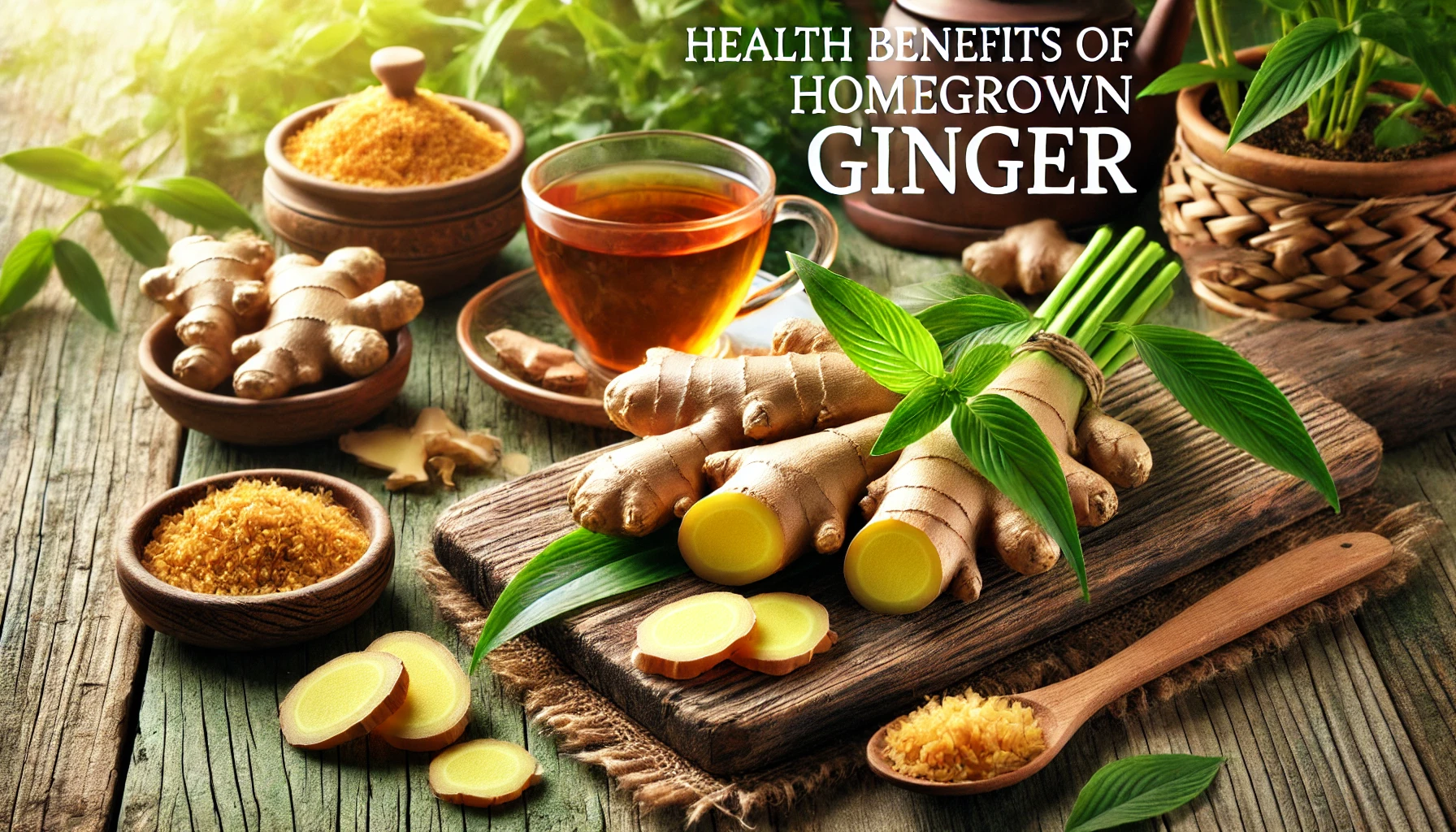
Nutritional Value of Ginger
Ginger is packed with essential nutrients and bioactive compounds that contribute to its numerous health benefits. Here are some key components found in ginger:
- Gingerol: The primary bioactive compound in ginger, responsible for its medicinal properties.
- Vitamins: Ginger contains vitamins B6 and C, which are important for immune function and energy production.
- Minerals: It provides essential minerals such as potassium, magnesium, and manganese.
- Antioxidants: Ginger is rich in antioxidants that help protect your cells from damage caused by free radicals.
Digestive Health
One of the most well-known benefits of ginger is its ability to aid digestion. Here’s how homegrown ginger can support your digestive system:
- Stimulates Digestive Juices: Ginger stimulates the production of saliva, bile, and gastric juices, which help break down food more effectively.
- Relieves Nausea: Ginger is particularly effective in reducing nausea and vomiting, whether due to morning sickness during pregnancy, chemotherapy, or motion sickness.
- Eases Indigestion: Consuming ginger can help relieve indigestion and discomfort in the stomach by speeding up the emptying of the stomach.
- Reduces Gas and Bloating: Ginger helps relax the gastrointestinal muscles, reducing gas and bloating.
Anti-Inflammatory and Pain Relief
Ginger’s anti-inflammatory properties make it a natural remedy for various inflammatory conditions and pain relief:
- Reduces Inflammation: The gingerol in ginger has powerful anti-inflammatory effects, making it beneficial for conditions like osteoarthritis and rheumatoid arthritis.
- Pain Relief: Ginger can help alleviate pain from menstrual cramps, migraines, and muscle soreness. Its analgesic properties are comparable to some over-the-counter pain medications.
Immune System Support
Homegrown ginger can boost your immune system and help your body fight off infections:
- Antimicrobial Properties: Ginger has antimicrobial properties that can help protect against bacterial and viral infections.
- Cold and Flu Relief: Ginger tea is a popular remedy for cold and flu symptoms. It can help reduce congestion, soothe a sore throat, and promote sweating, which helps the body eliminate toxins.
- Immune Boosting: The antioxidants in ginger support the immune system and enhance its ability to fight infections.
Cardiovascular Health
Including homegrown ginger in your diet can have positive effects on your heart health:
- Lowers Blood Pressure: Ginger acts as a natural blood thinner and can help lower blood pressure, reducing the risk of heart disease.
- Reduces Cholesterol Levels: Studies have shown that ginger can reduce levels of LDL cholesterol (the “bad” cholesterol) and triglycerides, contributing to improved cardiovascular health.
- Improves Blood Circulation: Ginger improves blood circulation by relaxing the muscles around blood vessels, which can help prevent blood clots and reduce the risk of stroke.
Blood Sugar Control
Ginger may help manage blood sugar levels and improve insulin sensitivity:
- Regulates Blood Sugar: Some studies suggest that ginger can lower fasting blood sugar levels and improve markers for long-term blood sugar control.
- Enhances Insulin Sensitivity: By enhancing insulin sensitivity, ginger can help prevent and manage type 2 diabetes.
Anti-Cancer Properties
Emerging research suggests that ginger may have anti-cancer properties:
- Inhibits Cancer Cell Growth: Gingerol has been found to inhibit the growth of cancer cells in various types of cancer, including ovarian, pancreatic, and breast cancer.
- Reduces Inflammation: Chronic inflammation is linked to the development of cancer. Ginger’s anti-inflammatory properties can help reduce the risk of cancer.
Weight Management
Ginger can support weight loss and weight management efforts:
- Boosts Metabolism: Ginger can increase the thermic effect of food, which means it helps your body burn more calories during digestion.
- Suppresses Appetite: Consuming ginger may help reduce feelings of hunger, making it easier to stick to a healthy eating plan.
Ginger Recipe
Homegrown ginger is not only fresher and more flavorful than store-bought ginger but also packed with numerous health benefits. Incorporating this versatile root into your daily diet can be easy and enjoyable. Here are several ways to use homegrown ginger:
1. Ginger Tea
Ginger tea is a simple and soothing way to enjoy the benefits of ginger. It’s particularly effective for alleviating nausea, improving digestion, and providing warmth during cold days.
How to Make Ginger Tea:
- Slice or grate a small piece of fresh ginger root (about 1-2 inches).
- Boil 2 cups of water and add the ginger slices.
- Let it simmer for 10-15 minutes, depending on how strong you like it.
- Strain the tea into a cup and add honey or lemon for added flavor and health benefits.
- Enjoy your hot cup of ginger tea!
2. Ginger Smoothies
Adding ginger to your smoothies not only enhances the flavor but also boosts the nutritional value. Ginger’s zing can balance the sweetness of fruits and add a refreshing twist.
Ginger Smoothie Recipe:
- 1 cup of fresh or frozen fruit (such as mango, pineapple, or berries).
- 1 cup of leafy greens (like spinach or kale).
- 1 small piece of fresh ginger (about 1 inch), peeled and grated.
- 1 cup of liquid (such as water, coconut water, or almond milk).
- Optional: add yogurt, chia seeds, or protein powder for extra nutrition.
- Blend until smooth and enjoy a delicious, health-boosting smoothie.
3. Cooking
Ginger is a staple in many cuisines around the world. It can be used in savory dishes to add depth and spice, particularly in Asian and Indian recipes.
Popular Ways to Use Ginger in Cooking:
- Stir-fries: Add freshly grated or sliced ginger to vegetable or meat stir-fries for a burst of flavor.
- Soups and Stews: Enhance the taste of soups and stews by adding ginger during cooking. It pairs especially well with chicken, carrots, and squash.
- Marinades: Create a flavorful marinade for meat, fish, or tofu by combining ginger with garlic, soy sauce, and a bit of honey.
- Curries: Use ginger as a key ingredient in curry pastes and sauces. It complements spices like turmeric, cumin, and coriander.
4. Baking
Ginger adds a warm, spicy note to baked goods, making it a popular ingredient in many sweet recipes.
Baking with Ginger:
- Gingerbread: Classic gingerbread cookies or cakes use ground ginger or fresh ginger for a festive flavor.
- Ginger Muffins: Add grated ginger to your muffin batter for a zesty twist.
- Ginger Scones: Fresh ginger can be incorporated into scone dough for a unique and delicious breakfast treat.
- Ginger Cakes: Use fresh ginger in cake recipes to create moist and aromatic cakes.
5. Ginger Juices
Fresh ginger juice is a powerful addition to any juice blend, offering a sharp, spicy flavor and numerous health benefits.
How to Use Ginger in Juices:
- Green Juice: Combine ginger with greens like kale, spinach, cucumber, and celery for a nutrient-packed juice.
- Citrus Juice: Blend ginger with oranges, lemons, and grapefruits for a refreshing and immune-boosting drink.
- Carrot and Apple Juice: Add ginger to a blend of carrots and apples for a sweet and spicy juice that’s great for digestion.
6. Ginger Salads
Ginger can be used in salad dressings and as an ingredient in salads to add a spicy kick.
Ginger Salad Dressing:
- 1 small piece of fresh ginger, grated.
- 2 tablespoons of soy sauce.
- 1 tablespoon of rice vinegar.
- 1 tablespoon of sesame oil.
- 1 teaspoon of honey or maple syrup.
- Mix all the ingredients together and drizzle over your favorite salad.
7. Pickled Ginger
Pickled ginger is a common accompaniment to sushi, but it can also be enjoyed with other dishes.
How to Make Pickled Ginger:
- Slice fresh ginger thinly.
- Boil a mixture of rice vinegar, sugar, and salt until the sugar dissolves.
- Pour the mixture over the ginger slices and let it sit for at least a few hours or overnight in the refrigerator.
- Enjoy pickled ginger with sushi, salads, or as a palate cleanser.
8. Ginger-infused Water
Infusing water with ginger is a simple way to make your hydration routine more interesting and beneficial.
How to Make Ginger-infused Water:
- Add slices of fresh ginger to a pitcher of water.
- Let it sit in the refrigerator for a few hours to allow the flavors to meld.
- Drink the infused water throughout the day for a refreshing and health-boosting beverage.
9. Ginger Syrup
Ginger syrup can be used in a variety of ways, from sweetening teas and cocktails to drizzling over pancakes and waffles.
How to Make Ginger Syrup:
- Combine equal parts water and sugar in a saucepan.
- Add thinly sliced ginger and bring the mixture to a boil.
- Simmer for about 10 minutes, then let it cool and strain out the ginger.
- Store the syrup in the refrigerator and use it as needed.
10. Ginger Oil
Ginger oil, made by infusing ginger in a carrier oil, can be used for cooking or as a topical treatment for muscle pain.
How to Make Ginger Oil:
- Peel and grate fresh ginger.
- Place the ginger in a jar and cover it with a carrier oil, such as olive or coconut oil.
- Let the mixture sit in a warm, sunny spot for a few weeks, shaking it occasionally.
- Strain out the ginger and store the oil in a cool, dark place.
Homegrown ginger offers a multitude of health benefits and can be used in various ways to enhance your meals and beverages. From teas and smoothies to cooking and baking, the versatility of ginger makes it an invaluable addition to your kitchen. By incorporating ginger into your daily routine, you can enjoy its numerous health benefits while adding flavor and excitement to your diet. Whether you’re soothing an upset stomach, boosting your immune system, or simply enjoying its unique taste, homegrown ginger is a wonderful and healthy choice.
Incorporate ginger into your daily routine through various recipes and enjoy the multitude of health benefits it offers. Whether you’re looking to improve digestion, manage pain, or support your overall well-being, homegrown ginger is a fantastic and easy-to-grow option that can make a significant difference in your health. Start your ginger gardening journey today and experience the amazing benefits of this incredible root.
How to Grow Ginger
Growing ginger at home is a rewarding and enjoyable experience that brings a multitude of benefits. Not only is ginger a versatile ingredient in many culinary dishes, but it also boasts numerous health benefits, making it a valuable addition to your garden. This complete guide will walk you through every step of the process, from selecting the right ginger variety to planting, caring for, and harvesting your ginger plants. Whether you have a spacious garden or a small balcony, you can successfully grow your own ginger and enjoy its fresh, aromatic flavor all year round.

Ideal Weather Conditions for Growing Ginger
| Factor | Ideal Condition |
|---|---|
| Climate | Warm and tropical; temperatures between 68°F to 86°F (20°C to 30°C) |
| Sunlight | Partial shade to full sun; at least 2-5 hours of sunlight daily |
| Soil | Well-draining, loamy soil with a pH of 5.5 to 6.5 |
| Watering | Consistently moist but not waterlogged; regular, deep watering |
| Humidity | High humidity, around 70-90% |
| Planting Time | Spring, after the last frost, when soil temperatures are warm |
| Spacing | Plant rhizomes 8-12 inches apart, 2-4 inches deep |
| Fertilization | Organic compost or balanced fertilizer every 6-8 weeks |
| Mulching | Use organic mulch to retain moisture and control weeds |
| Container Size | For container growing, use a pot at least 12 inches deep and wide |
This table provides a quick reference to the ideal growing conditions for ginger, helping ensure your ginger plants thrive and produce a bountiful harvest.
Methods of Growing Ginger
Growing ginger is a fun and rewarding experience. There are three main ways to grow ginger: using rhizomes, seeds, and cuttings. Each method has its own benefits and challenges, so you can choose the best one for your garden.
Sure! Here’s an easy-to-read guide on the four methods of growing ginger: from rhizomes, seeds, cuttings, and hydroponics.
1. Growing Ginger from Rhizomes
What is a Rhizome?
A rhizome is a part of the ginger plant that looks like a chunky root.
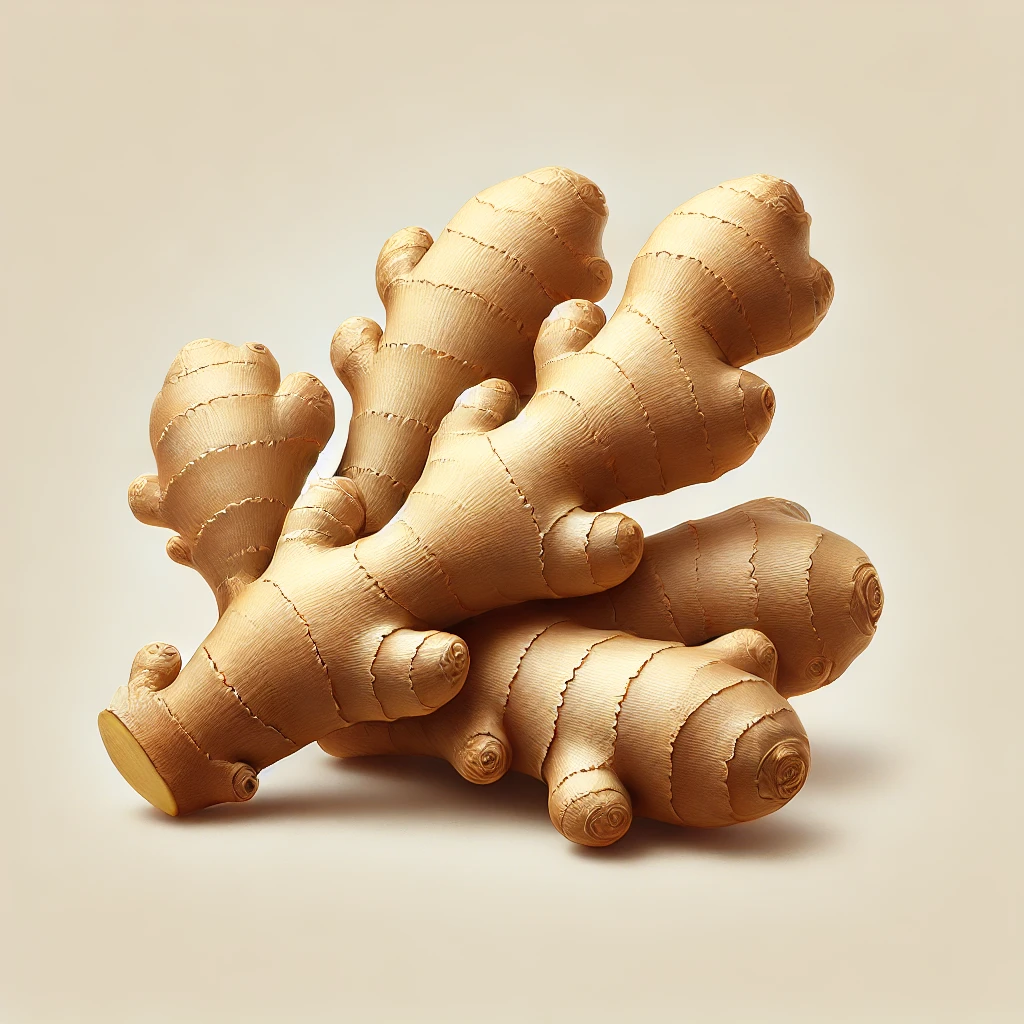
Steps:
- Choose Your Rhizome: Buy a fresh, plump ginger rhizome from a garden center or grocery store.
- Cut into Pieces: Cut the rhizome into smaller pieces, each with at least one “eye” (a small bud).
- Prepare the Soil: Use well-draining soil in a pot or garden bed.
- Plant: Place each piece in the soil about 2-4 inches deep with the “eye” facing up.
- Water and Care: Water regularly and keep the soil moist but not waterlogged. Ensure it gets partial shade to full sun.
Pros: Fast growth, easy, and reliable.
Cons: Limited variety.
2. Growing Ginger from Seeds
What are Ginger Seeds?
Ginger seeds are tiny seeds that can grow into ginger plants.
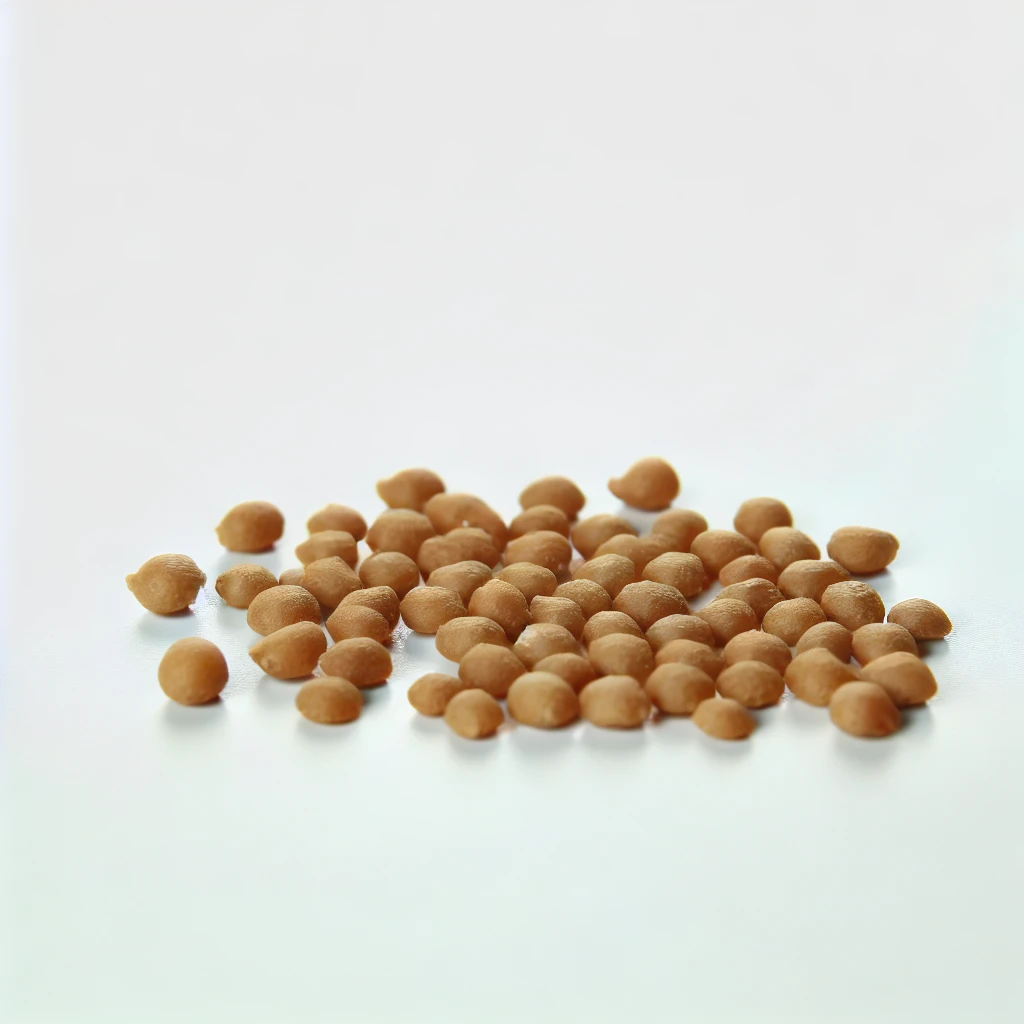
Steps:
- Get Seeds: Purchase ginger seeds from a reputable supplier.
- Prepare Seedlings: Start seeds indoors in small pots with seed-starting mix.
- Germination: Keep the soil moist and warm (about 75-85°F). Seeds can take several weeks to sprout.
- Transplant: Once seedlings are a few inches tall, transplant them into larger pots or your garden.
Pros: More variety and genetic diversity.
Cons: Slower growth and more challenging.
3. Growing Ginger from Cuttings
What are Ginger Cuttings?
Cuttings are pieces of the ginger plant stem that can grow new roots and shoots.
Steps:
- Get a Cutting: Cut a section of the stem from a mature ginger plant with at least one node (a swollen area where roots can grow).
- Dry the Cutting: Let the cutting dry for a few hours.
- Plant: Plant the cutting in a pot with well-draining soil, keeping the node just above the soil.
- Water and Care: Water regularly and provide partial shade until new growth appears.
Pros: Fast propagation of specific varieties.
Cons: Requires a mature plant and has a lower success rate.
Conclusion
- Rhizomes are the easiest and fastest method.
- Seeds offer more variety but take longer and are more challenging.
- Cuttings are good for propagating specific plants but need a mature plant.
Choose the method that best fits your needs and gardening experience!
Ideal Soil Mix Ingredients for Growing Ginger
| Ingredient | Description | Proportion |
|---|---|---|
| Garden Soil | Provides essential nutrients and structure | 40% |
| Compost | Adds organic matter, improves soil fertility | 30% |
| Coco Coir | Enhances water retention and aeration | 20% |
| Perlite | Increases drainage and prevents soil compaction | 10% |
| Optional: Sand | Improves drainage in heavier soils (use if needed) | Up to 10% |
Additional Notes:
- pH Level: Ensure the soil mix has a slightly acidic to neutral pH (5.5 to 6.5).
- Fertilizer: Add a balanced, slow-release fertilizer to the mix if the garden soil lacks nutrients.
- Sterilization: Consider sterilizing garden soil to eliminate pests and diseases.
- Mulching: Use organic mulch on top of the soil mix to retain moisture and regulate temperature.
This table provides a balanced mix that ensures good drainage, aeration, and nutrient availability, promoting healthy ginger growth.
Use the soil mix immediately for planting ginger or store it in a covered container to keep it fresh and pest-free. This balanced mix provides the necessary nutrients, aeration, and drainage for healthy ginger growth.
Where Can I plant Ginger?
In the Garden
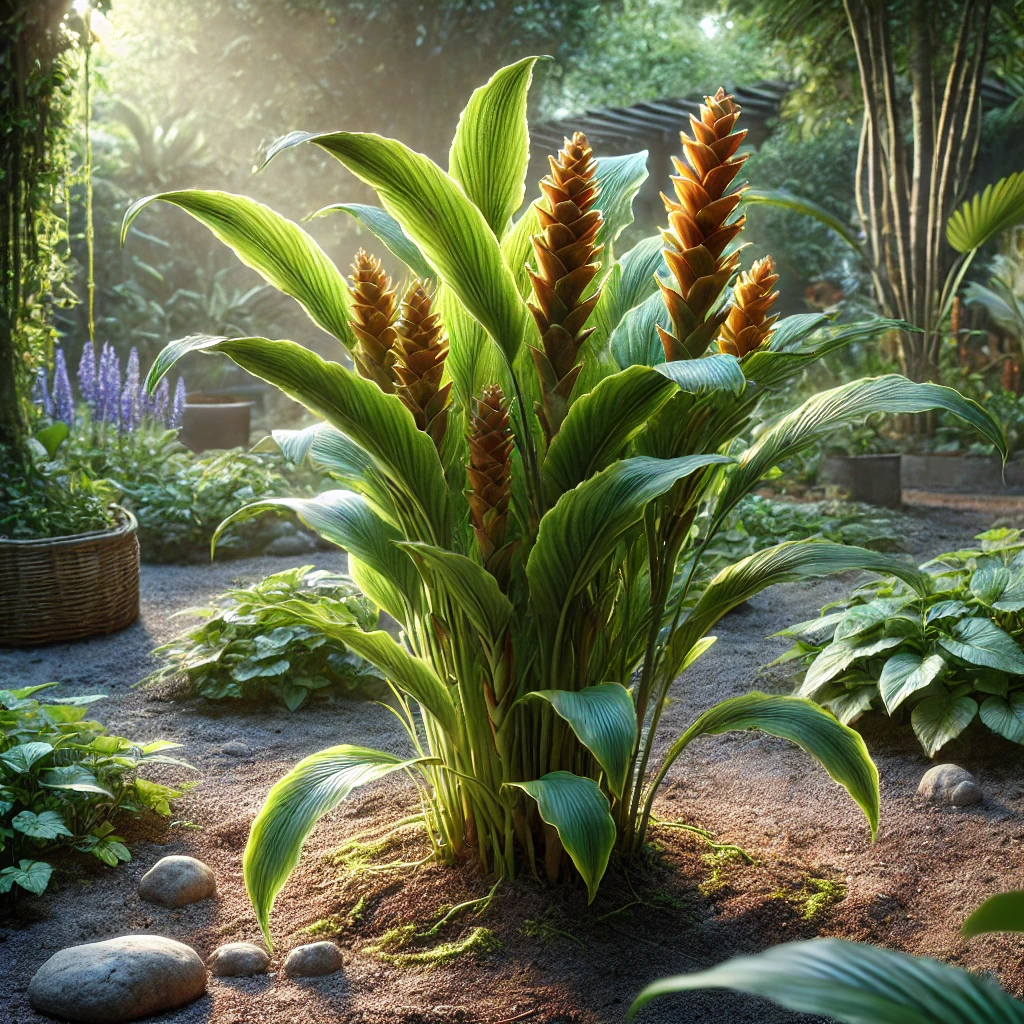
Plant ginger in a garden spot that gets partial shade to full sun, with protection from strong winds. Use well-draining, loamy soil rich in organic matter, and plant ginger pieces 8-12 inches apart to give them room to grow.
- Advantages: Natural growing conditions, more space for roots to spread.
- Disadvantages: Exposure to pests, weather fluctuations, and soil-borne diseases.
In Containers
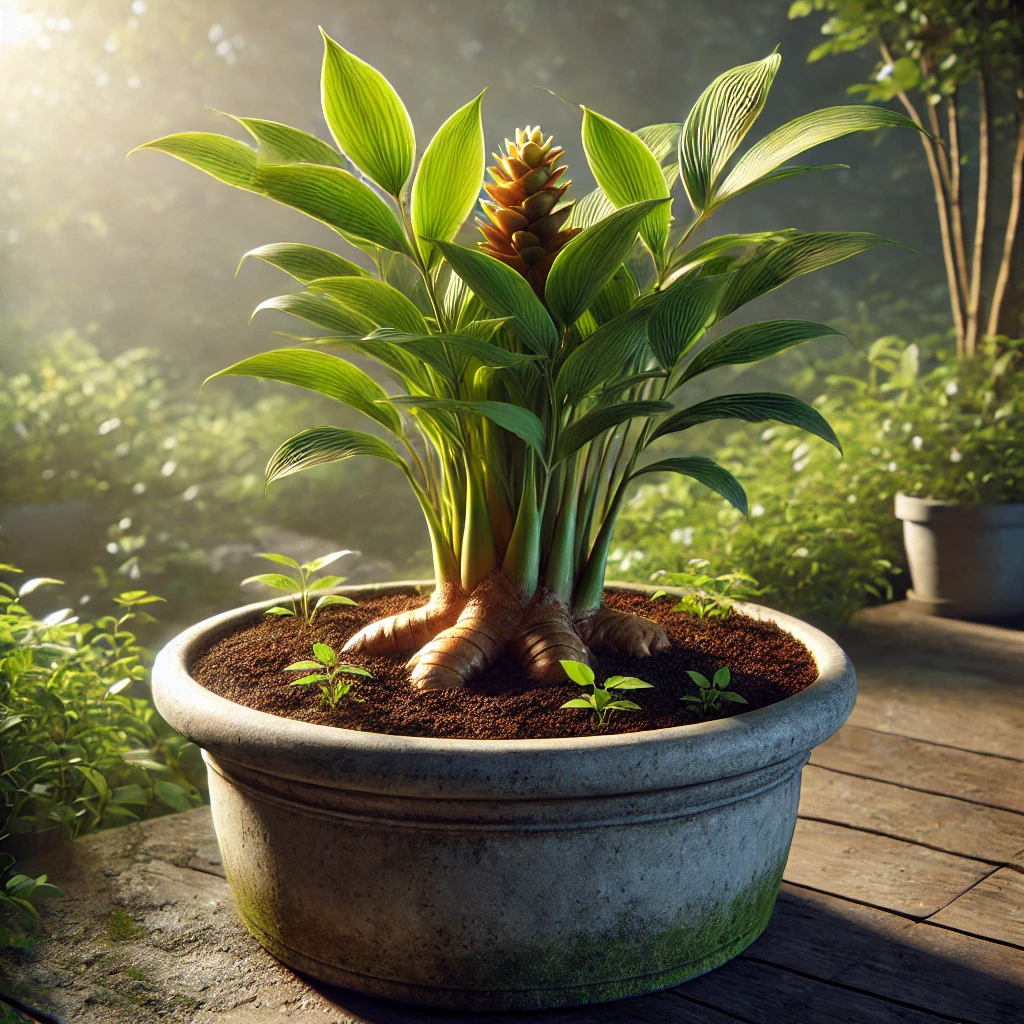
Choose a pot that is at least 12 inches deep and wide with drainage holes to prevent waterlogging. Fill the pot with a mix of garden soil, compost, coco coir, and perlite, and place it in a spot with partial shade to full sun, such as a balcony, patio, or windowsill.
- Advantages: Control over soil quality, easy to move, less risk of soil-borne diseases.
- Disadvantages: Limited root space, frequent watering needed, may need repotting.
Indoors
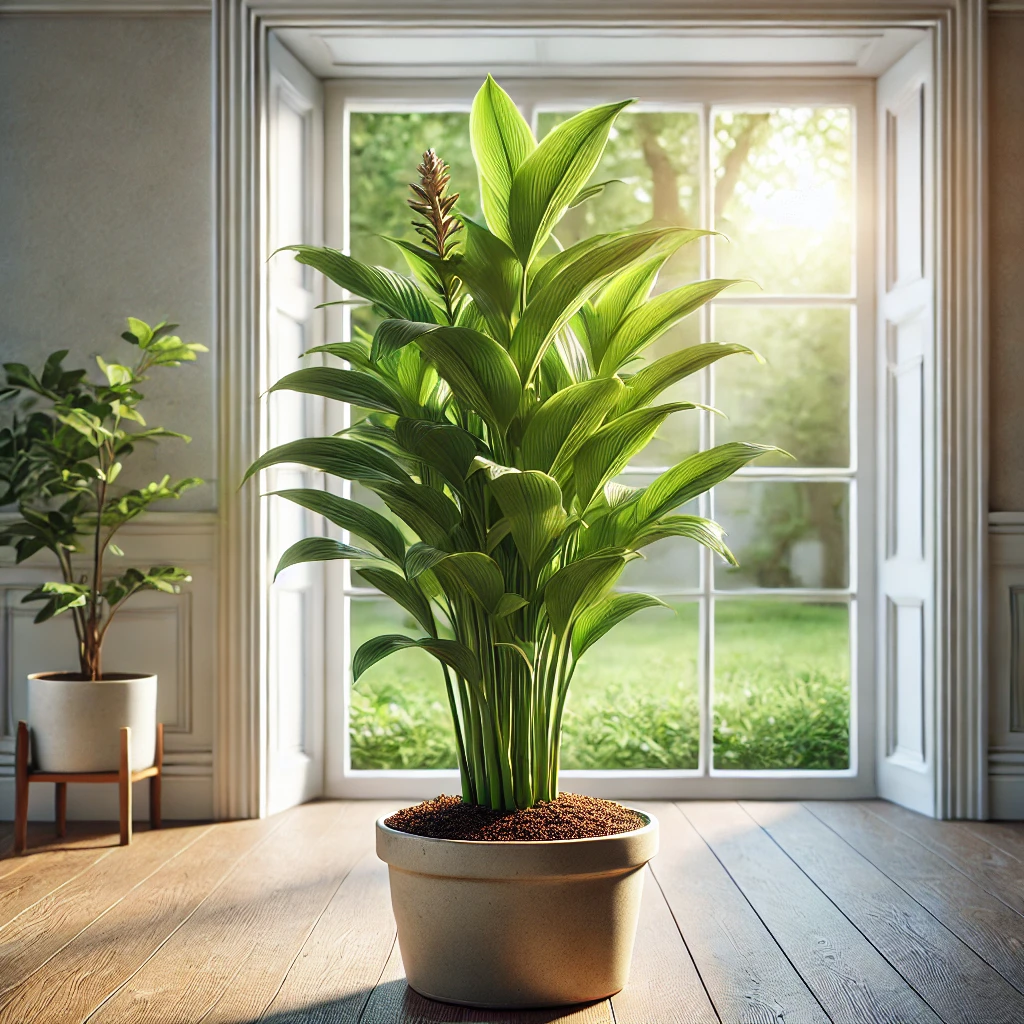
Place the ginger plant near a window where it can receive indirect sunlight or use a grow light. Keep the indoor temperature between 68°F to 86°F (20°C to 30°C) and increase humidity by misting the plant or using a humidity tray.
- Advantages: Protection from pests and extreme weather, easy to control environment.
- Disadvantages: Space limitations, need for consistent humidity, may require grow lights.
Greenhouse
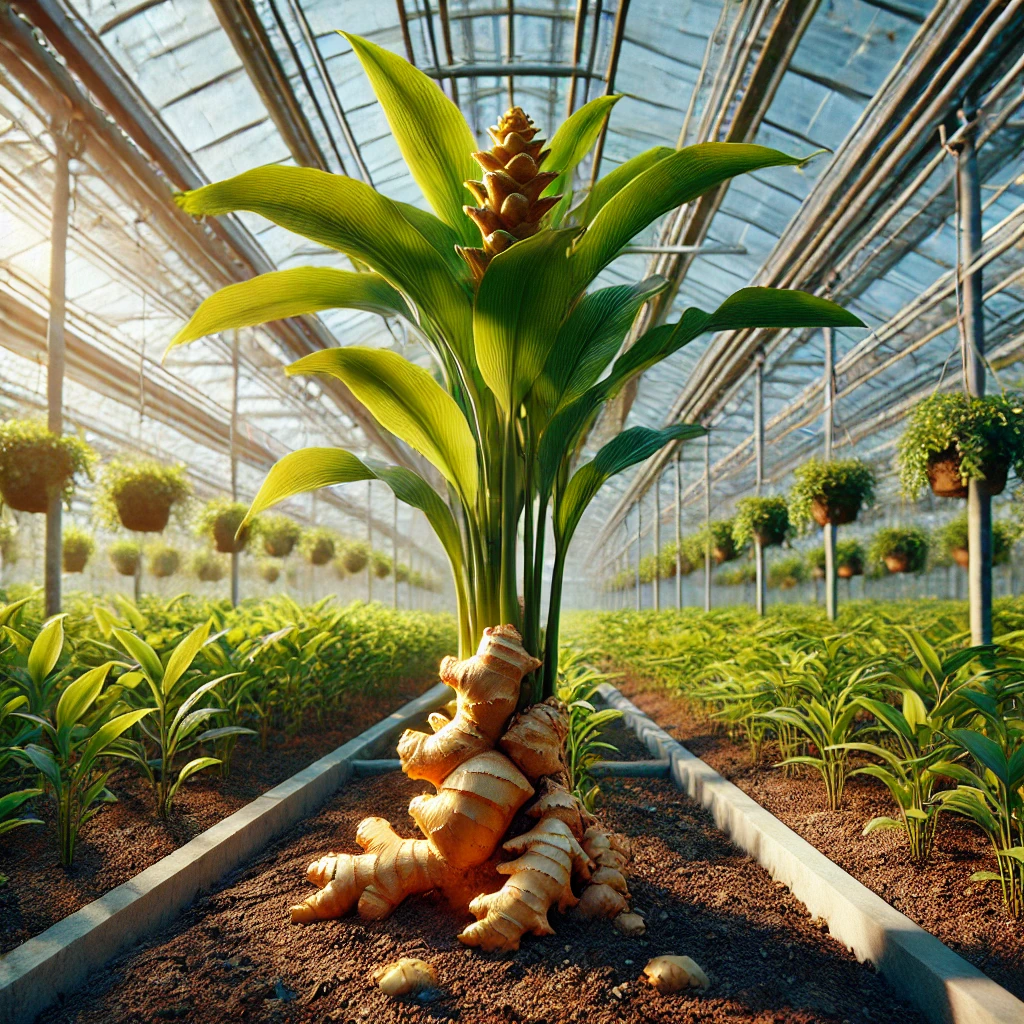
A greenhouse provides the consistent warmth and humidity that ginger loves. Ensure the greenhouse allows for partial shade to full sun, maintains a temperature between 68°F to 86°F, and has proper ventilation to prevent mold and mildew.
- Advantages: Controlled environment, protection from pests and diseases, extended growing season.
- Disadvantages: Higher setup and maintenance costs, requires space and resources.
Raised Beds
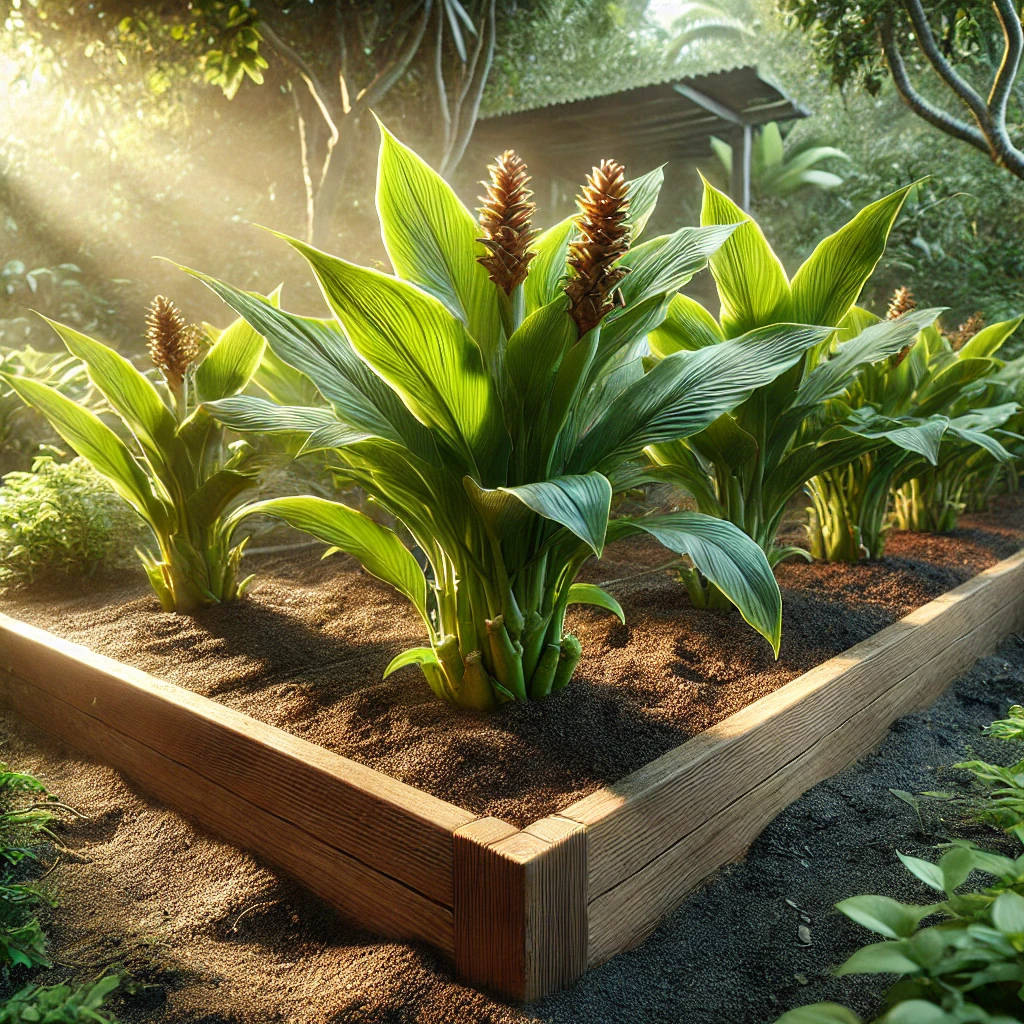
Raised beds let you control the soil quality and drainage effectively. Use well-draining, loamy soil rich in organic matter, and plant ginger pieces 8-12 inches apart in a spot that receives partial shade to full sun.
- Advantages: Better control over soil conditions, improved drainage, easier to manage.
- Disadvantages: Initial setup effort, potential need for frequent watering, limited space.
Ginger can be successfully grown in various locations, each with its own advantages and disadvantages. Whether planting in a garden, container, indoors, greenhouse, or raised bed, ensure optimal conditions such as well-draining soil, adequate sunlight, and proper care. Choose the method that best fits your space, resources, and gardening experience to enjoy a healthy and productive ginger harvest.
Care for Ginger Plant based of each growth stage
This comprehensive guide will walk you through the process of watering and fertilizing ginger plants at each growth stage, from planting to harvesting. By understanding the specific needs of ginger during its various stages of growth, you can optimize your fertilization practices to achieve the best results.
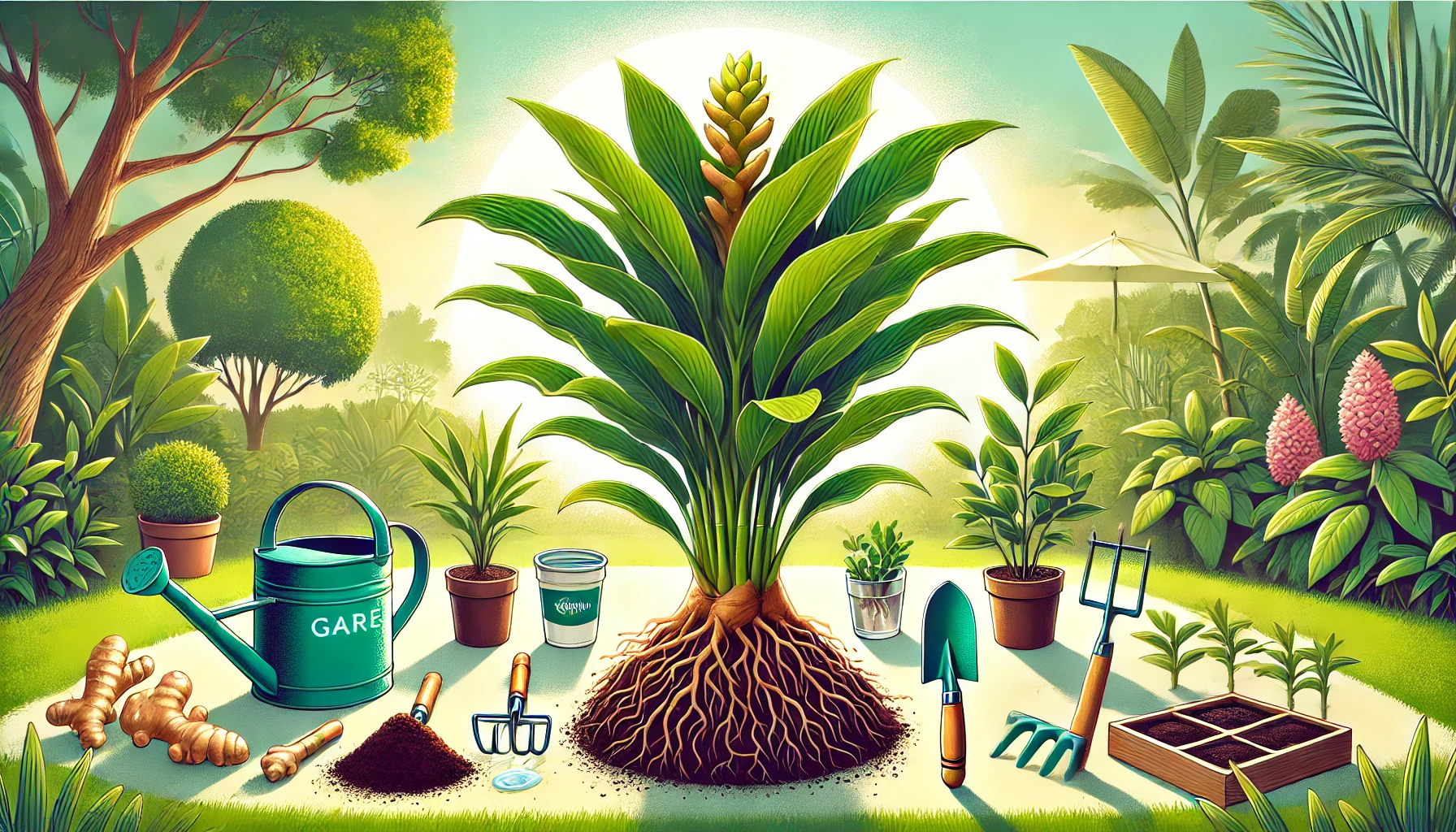
At first lets see table table outlining the stages of growth for ginger plants, including the duration and key signs of each stage:
| GROWTH STAGE | DURATION | KEY SIGNS |
|---|---|---|
| Planting | 1-2 weeks | – Rhizomes are planted in prepared soil. |
| Sprouting | 2-4 weeks | – Shoots begin to emerge from the soil. |
| Vegetative Growth | 2-5 months | – Rapid growth of leaves and stems. |
| Flowering and Bulking | 4-6 months | – Some plants may produce flowers. |
| – Rhizomes begin to bulk up and swell. | ||
| Harvesting | 8-10 months | – Leaves and stems start to yellow and die back. |
| – Rhizomes are mature and ready for harvest. |
This table provides a clear overview of each growth stage, how long it typically lasts, and the key signs to look for.
Here’s a table summarizing the NPK ratios and other key nutrients for various organic fertilizers commonly used in gardening:
| FERTILIZER | NUTRIENTS | BENEFITS |
|---|---|---|
| Compost | NPK: 1-1-1, Balanced nutrients | Improves soil structure, increases microbial activity, enhances water retention |
| Manure | NPK: Varies (e.g., 0.5-0.2-0.4), Balanced nutrients | Adds organic matter, provides slow-release nutrients, improves soil aeration |
| Bone Meal | NPK: 4-12-0, High in phosphorus | Promotes root development, enhances flowering |
| Blood Meal | NPK: 12-0-0, High in nitrogen | Promotes lush growth, helps compost decomposition |
| Fish Emulsion | NPK: 5-2-2, Rich in micronutrients | Fast-acting, boosts plant growth |
| Seaweed Extract | NPK: 1-0-4, Trace minerals, growth hormones | Improves stress tolerance, enhances root development |
| Green Manure | NPK: Varies (e.g., 2-1-2), Nitrogen (legumes), organic matter | Adds organic matter, suppresses weeds, fixes nitrogen |
| Worm Castings | NPK: 1-0-0, Beneficial microbes | Enhances soil structure, provides slow-release nutrients |
| Alfalfa Meal | NPK: 3-1-2, Growth hormones | Promotes soil microbial activity, improves plant vigor |
| Cottonseed Meal | NPK: 6-2-1, Balanced nutrients | Acidifies soil, provides slow-release nutrients, improves soil texture |
| Bat Guano | NPK: 10-3-1, High in nitrogen | Promotes vigorous growth, rich in beneficial microbes |
| Feather Meal | NPK: 12-0-0, High in nitrogen | Slow-release fertilizer, promotes lush foliage |
| Neem Cake | NPK: 5-1-2, Balanced nutrients | Acts as a pesticide, enhances soil fertility, improves plant health |
| Kelp Meal | NPK: 1-0-2, Trace minerals | Promotes strong root development, enhances stress resistance |
| Coffee Grounds | NPK: 2-0.3-0.2, Nitrogen | Improves soil structure, attracts beneficial microorganisms |
| Molasses | NPK: 1-0-5, Energy source for microbes | Improves soil structure, enhances nutrient uptake |
| Rock Phosphate | NPK: 0-3-0, High in phosphorus | Promotes root growth, enhances flowering and fruiting |
| Wood Ash | NPK: 0-1-3, Potassium, calcium | Raises soil pH, provides potassium, contains trace elements |
| Epsom Salt | NPK: 0-0-0, Magnesium sulfate | Improves chlorophyll production, enhances nutrient uptake |
| Banana Peel Fertilizer | NPK: 0-3-42 (approximate), Potassium | Promotes strong root growth, enhances flowering and fruiting |
| Mustard Cake | NPK: 4-1-1, Balanced nutrients | Enhances soil fertility, promotes healthy plant growth |
| Eggshell Fertilizer | NPK: 1.2-0.4-0.1 (approximate), Calcium | Improves soil structure, reduces soil acidity, strengthens plant cell walls |
Taking Care of Ginger Plant
1. Planting Stage
Proper care during the planting stage is crucial for healthy ginger growth.
- Watering: Keep the soil evenly moist but not waterlogged. Water regularly to keep the soil damp. Overwatering can cause root rot, so ensure good drainage.
- Fertilizing: Use a balanced, slow-release fertilizer or organic compost when planting. Apply a balanced liquid fertilizer (10-10-10) every 4-6 weeks. Avoid over-fertilizing to prevent too much foliage growth.
- Pruning: Pruning is usually not needed during the planting stage. Remove any damaged or diseased leaves to keep the plant healthy.
- Mulching: Apply a layer of organic mulch like straw or grass clippings around the plants. Mulch helps retain moisture, regulate temperature, and suppress weeds. Keep mulch away from the plant stems to prevent rot.
- Light and Temperature: Ginger prefers partial shade to full sun. In hot climates, provide shade during the hottest part of the day. Maintain a warm temperature between 68°F to 86°F (20°C to 30°C).
- Pest and Disease Control: Check regularly for pests like aphids and spider mites. Use organic insecticides or introduce beneficial insects like ladybugs. Ensure good air circulation and avoid overhead watering to prevent diseases.
- Soil Maintenance: Keep the soil loose and well-aerated. Maintain a slightly acidic to neutral pH (5.5 to 6.5). Test the soil periodically and adjust pH with lime or sulfur if needed.
Taking care of ginger during the planting stage involves proper watering, fertilizing, minimal pruning, mulching, and pest control. Providing these conditions will help your ginger plants grow strong and healthy.
2. Sprouting Stage
Proper care during the sprouting stage is essential for healthy ginger growth. Follow these steps:
- Watering
- Keep the soil consistently moist but not soggy.
- Water the plants regularly to ensure the soil remains damp.
- Avoid overwatering to prevent root rot.
- Fertilizing
- Use a balanced liquid fertilizer (10-10-10) every 4-6 weeks.
- Add organic compost to enrich the soil.
- Light and Temperature
- Provide partial shade to full sun.
- In hot climates, give shade during the hottest part of the day.
- Maintain a warm temperature between 68°F to 86°F (20°C to 30°C).
- Mulching
- Apply a layer of organic mulch like straw or grass clippings around the plants.
- Mulch helps retain moisture, regulate soil temperature, and suppress weeds.
- Keep the mulch away from the stems to prevent rot.
- Pest and Disease Control
- Monitor regularly for pests like aphids, spider mites, and mealybugs.
- Use organic insecticides or introduce beneficial insects like ladybugs.
- Ensure good air circulation and avoid overhead watering to keep foliage dry and prevent diseases.
- Soil Maintenance
- Keep the soil loose and well-aerated.
- Ensure the soil pH is slightly acidic to neutral (5.5 to 6.5).
- Test the soil periodically and adjust the pH with lime (to raise pH) or sulfur (to lower pH) if needed.
- Tips:
- Water consistently and avoid soggy soil.
- Fertilize every 4-6 weeks with balanced fertilizer.
- Provide proper light, temperature, and mulch.
- Monitor for pests and diseases.
- Maintain soil health and pH levels.
Following these steps will help your ginger plants grow strong and healthy during the sprouting stage.
3. Vegetative Growth Stage
Proper care during the vegetative growth stage is crucial for the development of healthy ginger plants. Follow these steps:
- Watering
- Keep the soil consistently moist but avoid waterlogging.
- Water regularly to maintain damp soil.
- Ensure good drainage to prevent root rot.
- Fertilizing
- Continue using a balanced liquid fertilizer like Miracle-Gro Liquid All Purpose Plant Food (10-10-10) every 4-6 weeks.
- Add organic compost to the soil to provide additional nutrients.
- Light and Temperature
- Provide partial shade to full sun.
- Protect plants from the hottest midday sun in very hot climates.
- Maintain a warm temperature between 68°F to 86°F (20°C to 30°C).
- Mulching
- Apply a layer of organic mulch, such as straw or grass clippings, around the plants.
- Mulch helps retain moisture, regulate soil temperature, and suppress weeds.
- Keep mulch away from the stems to prevent rot.
- Pruning
- Remove any yellow or dead leaves to encourage healthy growth.
- Trim back any damaged or diseased foliage to prevent spread.
- Pest and Disease Control
- Monitor for pests like aphids, spider mites, and mealybugs regularly.
- Use organic insecticides like Neem Oil or introduce beneficial insects like ladybugs.
- Ensure good air circulation and avoid overhead watering to prevent diseases.
- Soil Maintenance
- Keep the soil loose and well-aerated.
- Maintain slightly acidic to neutral soil pH (5.5 to 6.5).
- Test the soil periodically and adjust pH with lime (to raise pH) or sulfur (to lower pH) if needed.
- Tips
- Water consistently to keep the soil moist.
- Fertilize every 4-6 weeks with Miracle-Gro Liquid All Purpose Plant Food (10-10-10).
- Provide proper light and temperature, and use mulch.
- Prune dead or diseased foliage.
- Monitor and control pests and diseases with products like Neem Oil.
- Maintain soil health and pH levels.
Following these steps will help your ginger plants thrive during the vegetative growth stage, promoting strong and healthy development.
4. Flowering and Bulking Stage
Proper care during the flowering and bulking stage is essential for the development of healthy and productive ginger plants. Follow these steps:
- Watering
- Keep the soil consistently moist but not soggy.
- Water regularly to maintain damp soil, especially during dry spells.
- Ensure good drainage to prevent root rot.
- Fertilizing
- Switch to a phosphorus-rich fertilizer like Bone Meal (4-12-0) to encourage flowering and bulking.
- Apply the fertilizer every 4-6 weeks.
- Continue to add organic compost to the soil for extra nutrients.
- Light and Temperature
- Provide partial shade to full sun.
- Protect plants from the hottest midday sun in very hot climates.
- Maintain a warm temperature between 68°F to 86°F (20°C to 30°C).
- Mulching
- Apply a fresh layer of organic mulch, such as straw or grass clippings, around the plants.
- Mulch helps retain moisture, regulate soil temperature, and suppress weeds.
- Keep mulch away from the stems to prevent rot.
- Pruning
- Remove any yellow or dead leaves to encourage healthy growth.
- Trim back any damaged or diseased foliage to prevent spread.
- Pest and Disease Control
- Monitor for pests like aphids, spider mites, and mealybugs regularly.
- Use organic insecticides like Neem Oil or introduce beneficial insects like ladybugs.
- Ensure good air circulation and avoid overhead watering to prevent diseases.
- Soil Maintenance
- Keep the soil loose and well-aerated.
- Maintain slightly acidic to neutral soil pH (5.5 to 6.5).
- Test the soil periodically and adjust pH with lime (to raise pH) or sulfur (to lower pH) if needed.
- Tips
- Water consistently to keep the soil moist.
- Use a phosphorus-rich fertilizer like Bone Meal (4-12-0) every 4-6 weeks.
- Provide proper light and temperature, and use mulch.
- Prune dead or diseased foliage.
- Monitor and control pests and diseases with products like Neem Oil.
- Maintain soil health and pH levels.
Following these steps will help your ginger plants thrive during the flowering and bulking stage, promoting strong and healthy development, and ultimately leading to a bountiful harvest.
5. Harvesting Stage
Proper care during the harvesting stage is essential to ensure you get the best yield from your ginger plants. Follow these steps:
- When to Harvest
- Ginger is usually ready to harvest 8-10 months after planting.
- The leaves will start to turn yellow and die back, indicating the ginger is mature.
- Harvesting
- Gently dig around the plant to loosen the soil.
- Carefully lift the ginger rhizomes out of the ground.
- Shake off excess soil and trim off the foliage.
- Cleaning
- Rinse the ginger rhizomes under cool water to remove soil.
- Allow the rhizomes to dry in a cool, shaded area for a few hours.
- Storage
- Store fresh ginger rhizomes in a cool, dry place.
- For longer storage, keep the ginger in the refrigerator or freeze it.
- You can also store ginger by slicing and drying it.
- Replanting
- Save a few healthy rhizomes to replant for the next season.
- Cut rhizomes into pieces, each with at least one “eye” or bud.
- Plant these pieces following the initial planting steps.
- Tips
- Harvest ginger when the leaves turn yellow and die back, usually after 8-10 months.
- Carefully dig up the rhizomes, clean them, and allow them to dry.
- Store ginger in a cool, dry place, or refrigerate or freeze for longer storage.
- Save some rhizomes to replant for the next season.
Following these steps will help you harvest your ginger plants effectively, ensuring a good yield and preparing for future plantings.
Pests and Diseases of Ginger Plant: Symptoms, Causes, Cures, and Prevention
Ginger, a popular spice known for its medicinal properties, is not immune to diseases that can affect its growth and yield. Here, we explore some common diseases that afflict ginger, their symptoms, causes, cures, and prevention methods.
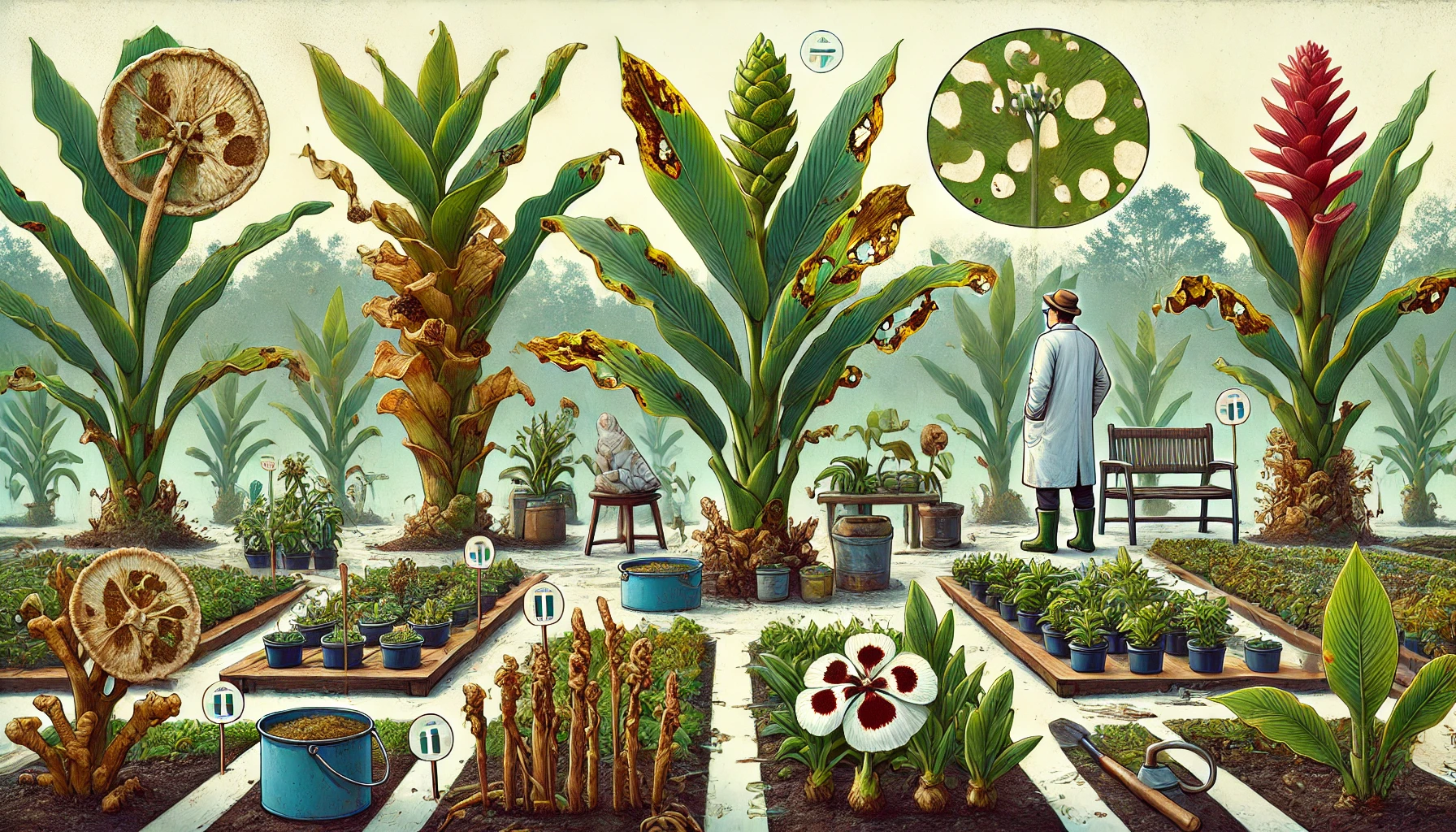
Common Pests and Diseases of Ginger Plants
Proper care and monitoring can help manage pests and diseases that affect ginger plants. Here are some common issues to look out for, along with recommended treatments:
Pests
- 1. Aphids
- Description: Small, soft-bodied insects that suck sap from the plant.
- Signs: Curling leaves, sticky residue (honeydew) on the leaves.
- Control: Use insecticidal soap or neem oil (organic insecticides), introduce ladybugs (biological control).
- 2. Spider Mites
- Description: Tiny, spider-like pests that are often found on the undersides of leaves.
- Signs: Yellowing leaves, fine webbing on the plant.
- Control: Spray with water to dislodge, use insecticidal soap or neem oil (organic insecticides).
- 3. Mealybugs
- Description: Small, white, cottony insects that cluster on the plant.
- Signs: White cottony masses on stems and leaves, stunted growth.
- Control: Use neem oil (organic insecticide) or a mixture of water and dish soap, remove by hand.
- 4. Root-Knot Nematodes
- Description: Microscopic worms that infect roots.
- Signs: Galls or knots on roots, poor plant growth.
- Control: Use soil solarization (cultural control), rotate crops (cultural control), apply nematicides (chemical control).
Diseases
- 1. Bacterial Wilt
- Description: Caused by Ralstonia solanacearum bacteria.
- Signs: Yellowing and wilting of leaves, brownish discoloration in stems.
- Control: Remove and destroy infected plants (cultural control), use disease-free planting material (cultural control), copper-based bactericides (chemical control).
- 2. Fusarium Wilt
- Description: Fungal disease caused by Fusarium oxysporum.
- Signs: Yellowing of leaves, brown streaks on stems, stunted growth.
- Control: Use resistant varieties (cultural control), rotate crops (cultural control), apply fungicides like thiophanate-methyl (chemical control).
- 3. Rhizome Rot
- Description: Caused by Pythium species, a water mold.
- Signs: Soft, mushy rhizomes, foul smell, wilting plants.
- Control: Ensure good drainage (cultural control), avoid overwatering (cultural control), apply fungicides like metalaxyl (chemical control).
- 4. Leaf Spot
- Description: Fungal disease causing spots on leaves.
- Signs: Brown or black spots on leaves, yellowing around spots.
- Control: Remove affected leaves (cultural control), use fungicides like Gravex 20 EW (chemical control), ensure good air circulation (cultural control).
To keep your ginger plants healthy, regularly monitor for pests like aphids, spider mites, mealybugs, and root-knot nematodes, and watch for diseases such as bacterial wilt, fusarium wilt, rhizome rot, and leaf spot. Early detection and proper management using organic insecticides, cultural practices, biological controls, and chemical treatments can help prevent and control these common issues.

